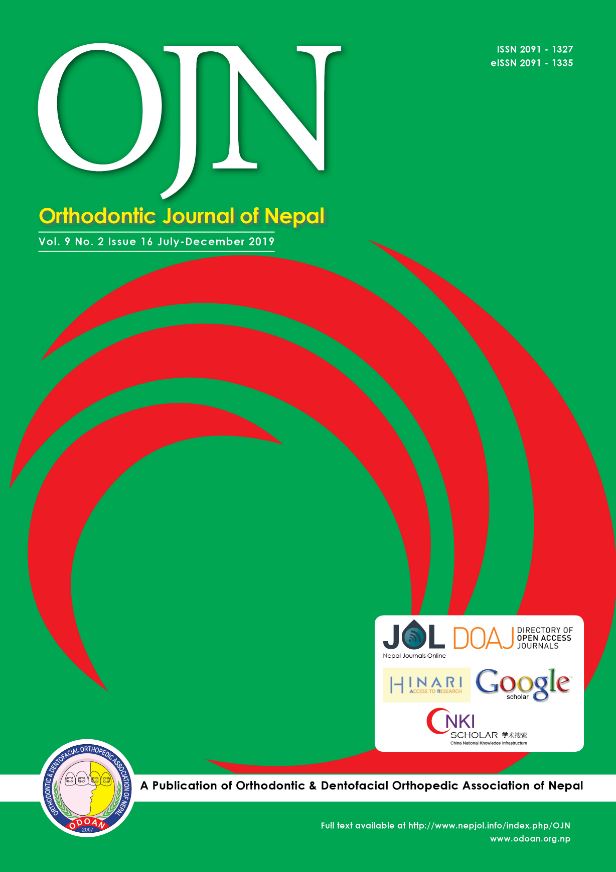Prevalence and Distribution of Dental Anomalies among Orthodontic Patients of Kathmandu, Nepal
DOI:
https://doi.org/10.3126/ojn.v9i2.28407Keywords:
Association, Dental anomalies, Orthodontic patients, PrevalenceAbstract
Introduction: Dental anomalies are commonly seen during regular dental check-up. It occurs due to abnormal morphodifferentiation of teeth during different stages of tooth development. The purpose of this study was to find out the of dental anomalies among orthodontic patients of Kathmandu, Nepal.
Materials & Method: A total of 601 patients (242 males and 359 females) of aged 10 to 35 years (mean age= 16.42±3.42 years) who require orthodontic treatment were selected. The patients were assessed clinically and dental panoramic radiographs were evaluated for disturbance in number and other anomalies. A chi-square test was used to determine the difference in the prevalence of dental anomalies between genders and among different classes of malocclusion.
Result: The prevalence of dental anomalies was 15.3% that is 92 participants were exhibited at least one dental anomaly among 601 orthodontic patients. Among dental anomalies, hypodontia was the most prevalent (7.48%) followed by hyperdontia (2.99%), microdontia (2.16%), macrodontia (0.66%), transposition (0.66%), taurodontism (0.49%), double teeth (0.33%), amelogenesis imperfecta (0.33%) and dentinogenesis imperfecta (0.16%). The prevalence of oligodontia was 0.33%. There were no statistically significant difference in prevalence of anomalies in between gender and among different classes of malocclusion.
Conclusion: Prevalence and distribution of some dental anomalies in orthodontic patients of Kathmandu differed from other studies. Maxillary lateral incisor was the most commonly missing and microdontic tooth. Orthodontists have the responsibility to observe each patient carefully for dental anomalies to correct or improvise this condition without any complications.
Downloads
Downloads
Published
How to Cite
Issue
Section
License
Copyright © held by Orthodontic & Dentofacial Orthopedic Association of Nepal
- Copyright on any research article is transferred in full to the Orthodontic & Dentofacial Orthopedic Association of Nepal upon publication in the journal. The copyright transfer includes the right to reproduce and distribute the article in any form of reproduction (printing, electronic media or any other form).
- Articles in the Orthodontic Journal of Nepal are Open Access articles published under the Creative Commons CC BY License (https://creativecommons.org/licenses/by/4.0/)
- This license permits use, distribution and reproduction in any medium, provided the original work is properly cited.




